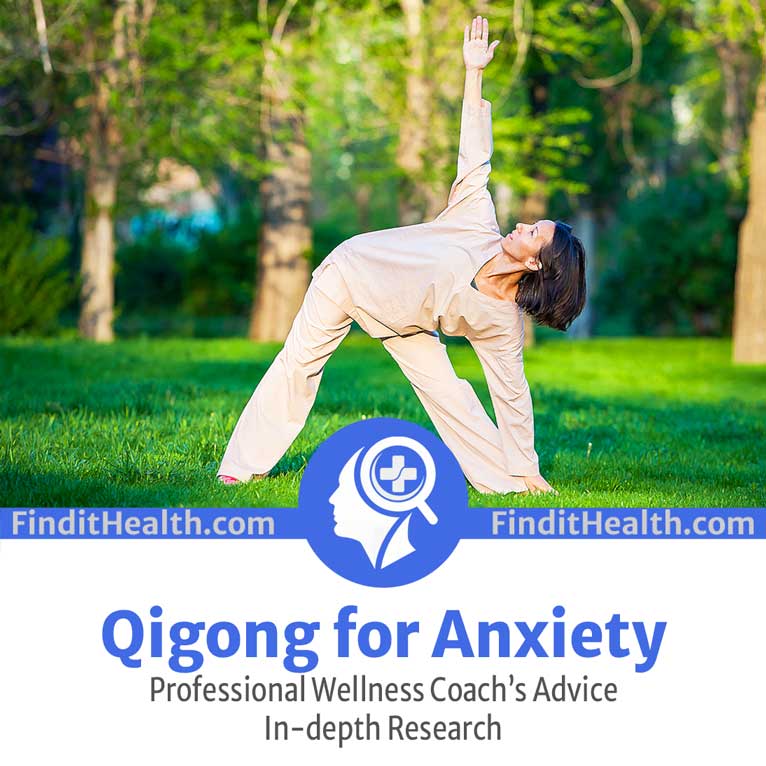
As the leader of the wellness coach team here at Find It Health, I will walk you through a comprehensive guide on how to use medical Qigong to manage anxiety and other symptoms of depression.
Our research team here at Find It Health commits to verifying and fact-checking all the health-related information we share with our readers.
Below, I will discuss everything you need to know about the use of Qigong and how you can use it to overcome anxiety.
Effectiveness of Qigong for Anxiety and Depression
The majority of studies reveal that qigong practices improve different psychological aspects like anxiety, clinical depression, mood, cognitive function, and stress management for people of all ages.
As you practice Qigong, you practice mindfulness because you use your mind to direct your energy.
This makes it a relaxing and efficient way of reducing anxiety and other symptoms of depression.
However, for you to get the anxiety reduction or depression management effect, there are specific types of health Qigong practices you should do. This is because medical Qigong involves several exercises that should bring different therapeutic effects.
For instance, if you intend to deal with depressive disorder, practices with an upward and outward movement of energy would help.
This is because clinical depression tends to lower your energy, and so, to counter this effect, you’ll need practices that build up your energy levels.
On the other hand, an anxious person should do an exercise that involves an inward and downward energy movement because he has a lot of scattered energy which needs to be recentered and rebalanced.
SUBSCRIBE for FREE STRESS MANAGEMENT TECHNIQUES from our EXPERT COACHES!
Qigong Routine For Anxiety
A good health Qigong trainer will advocate for simple regular physical exercises to help with anxiety symptom reduction and stress management.
The practices in this routine use rhythmic breathing and gentle movement of the hands to discard any excess stagnant energy in your body.
It ultimately brings many beneficial effects on your mental health and improves your quality of life.
Preparation for the Routine
Before you practice this medical Qigong routine, you need to be in the correct posture. First, stand with your feet on the ground, your knees slightly bent, your hand hanging loosely by your side, and your shoulders rolled back. Take three deep breaths and relax.
Pushing the Qi Forward
You start by breathing in as you lift your lower arms, bending it at the elbows with the palms facing you. Then breathe out as you push your hands forward, your palms facing outward. Then relax the hands back to your side.
As you do this, you visualize yourself bringing up all the excess energy in your body, holding it in your palms, and pushing it out.
Before doing the next physical exercise, take a few deep breaths and relax.
Pushing the Qi out
Like in the first practice, in this second practice, you also start by taking a deep breath as you pull your hands towards your shoulders. Then breathe out as you turn the palms to the sides and spread the hands out in a way that makes you form a ‘ T ‘.
As you do the practice, lift the excess Qi – that thought that is bothering you – be it having hair loss, all the negative reactions, something you think you did wrong, or anything giving you pressure, pull them all up as you lift your hands and push them out as you push your hands out.
Pushing the Qi with a twist
In this health qigong practice, you take a deep breath while lifting one of your hands, bending it at the elbow. Hold it in that position, twist your body to one side, and then breathe out as you push your hand toward that direction.
Twist back to your original posture as you return your hand down. Repeat the same with your other hand.
An exercise with such a breathing pattern also helps ease tinnitus pain when done along with acupuncture.
Circulating the Qi
In this last exercise, you start with your hands at the diaphragm level. You then bring up one hand at a time through the center of the body as you breathe in and push it straight forward with your palm facing outward as you breathe out.
Move your hands in a circular motion in front of you but avoid twisting your body.
This helps circulate the Qi from the ren-meridian. It helps open up the chest so any anxiety held up in your chest is carried up and pushed out.
To realize the effectiveness of the Qigong exercise, practice this routine for 5-20 minutes daily.
SUBSCRIBE for FREE STRESS MANAGEMENT TECHNIQUES from our EXPERT COACHES!
Qigong For Headaches
According to medical Qigong, a headache happens when an energy imbalance resulting from emotions, overthinking, change of weather, or poor nutrition happens.
Systematic reviews with clinical trials prove that Qigong interventions in combination with acupuncture can help alleviate headaches and migraines.
These two forms of exercise help to curb headaches.
- Relaxation qigong
A simple medical Qigong practice that exploits repeated muscle relaxation and mental focus to bring deep relaxation in the whole body.
- Head and face Qigong
This is a practice that involves massaging and deep breathing techniques. It’s designed to help with headaches, dizziness, and facial issues.
The following manipulations are made at specific acupressure points to cause an energy rebalancing in the head.
- Massaging the forehead from the center of the eyebrows upwards.
- Massaging the temples with your thumbs in circular motions.
- Wiping the face across the forehead with your palms.
- Brush the sides of your head from the temples forward with your first four fingers.
- Combine the hair with your fingers while grasping the scalp.
- Rubbing the base of your head with your locked fingers.
These acupressure points also help when administering other conventional Chinese therapies like acupuncture.
Qigong for Chest Tightness
According to several Chinese databases, the respiratory system functions include breathing, water metabolism, building self-esteem, maintaining psychological mechanisms, and boosting immune function.
Qigong exercises involve a combination of physical exercises with breathing techniques and mental focus. This makes it a helpful tool in strengthening the respiratory system.
Circling the hands
This is a common medical qigong practice used mainly for treating chest tightness. To practice this, you should be in a Qigong-ready position first, then start with an Opening exercise before doing the Circling-the-Hands practice. In Circling-the-Hands, you form two big circles with your hands by pushing one hand forward as the other is by your rib side coming up.
You then lower the first hand to the diaphragm level as the second one rises to the shoulder level. This is done repeatedly for some minutes before interrupting it with a Releasing-the-Qi and a Tapping-the-Chest Exercise. Then you do a Circling-the-Hands practice again and close up with an Opening exercise.
SUBSCRIBE for FREE STRESS MANAGEMENT TECHNIQUES from our EXPERT COACHES!
Qigong for Sleep Apnea
Sleep apnea is a sleeping disorder where one’s breathing stops repeatedly and restarts again when sleeping.
A majority of studies reveal that medical Qigong practices are effective conventional treatments for sleep apnea. These practices usually improve breathing while sleeping and improve sleep quality.
Practicing Qigong strengthens your respiratory system reducing the chances of experiencing airway collapses during sleep which is common in sleep apnea.
FindItHealth.com – Frequently Asked Questions
Do Qigong Practices Reduce Anxiety?
Yes. Qigong practices help reduce anxiety symptoms considerably.
Qigong is a conventional therapy that helps cultivate vital energy using different physical movements, meditation, and breathing patterns.
When you practice Qigong, you activate your parasympathetic nervous system, which ultimately improves your blood flow and causes the release of endorphins. This leaves you with deep relaxation.
What do the Chinese do for anxiety?
There are several Chinese therapies used widely among Chinese for managing anxiety. They include,
- Qigong practices
- Acupuncture
- Herbs
- Dietary therapy
- tai-chi
- Wet cupping and dry cupping
Each of these therapies is administered to every individual depending on their makeup and needs. These techniques can be used in solitude or as a combination of two or more techniques. For instance, your doctor may diagnose your case and recommend a wet-cupping procedure alongside dietary therapy.
Which Chakra to Balance for Anxiety?
Solar Plexus Chakra. This is the chakra to balance for anxiety reasons. It is located in your diaphragm under the ribs and is identified with yellow. This chakra regulates fear, gut feelings, and the sense of power.
If this chakra is unbalanced, you may experience fear, anxiety disorders, some eating disorders, and a feeling of loss of control. To balance it, surround yourself with the yellow stuff.
SUBSCRIBE for FREE STRESS MANAGEMENT TECHNIQUES from our EXPERT COACHES!
Conclusion
Capacious research conducted by our research team at Find It Health confirms that with appropriate Qigong exercise and consistent practice, you can improve your quality of life in different ways.
Qigong has many beneficial effects. One of the major positive effects of Qigong exercise is helping patients overcome symptoms of anxiety and depression.
Most people with different health issues like infertility, chronic illnesses like cancer, or other overwhelming thoughts develop depressive disorders or anxiety disorders. A simple qigong intervention could give a long-lasting solution if done correctly and improve the patient-health.
SUBSCRIBE for FREE STRESS MANAGEMENT TECHNIQUES from our EXPERT COACHES!


